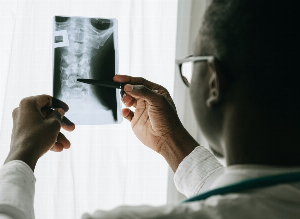Ankylosing spondylitis: Everything you need to know!
Published Jul 16, 2021 • By Aurélien De Biagi
Ankylosing spondylitis (AS) is responsible for pain and stiffness of the spine and large joints (hips, shoulders, etc.). Less than one percent of the US adult population are affected.
What is ankylosing spondylitis? Who does it affect? What are its symptoms and how is it treated?
We explain it all in our article!

What is ankylosing spondylitis?
Ankylosing spondylitis (AS) is a chronic inflammatory autoimmune disease affecting the intervertebral joints, sacroiliac joints (between the spine and pelvis) and entheses (the connective tissues between muscles and bones). In this condition, the immune system attacks these connective tissues, causing erosion of the surrounding bone in the process. Despite mechanisms for rebuilding the bone, it may not be able to rebuild itself properly, causing it to become thinner. This makes the vertebrae more susceptible to fracture.
In addition, the vertebrae will fuse together, making the spine rigid (ankylosis) and painful.
The condition is characterized by periods of flare-ups (painful attacks) and remissions. These flare-ups may last a few days or weeks before finally subsiding, although symptoms may persist during the remission period in severe forms. The prognosis is generally good and not life-threatening, but ankylosing spondylitis can cause disability.
Who gets ankylosing spondylitis?
Approximately 300,000 Americans (less than 1% of the adult population) are affected. Generally speaking, both sexes are affected by the disease. However, men are affected by more severe forms than women. As a result, women have long been under-diagnosed. In addition, patients are often young adults between 20 and 30 years of age, although the disease can occur earlier (in adolescence) or later.
There is also a genetic factor in the development of the disease. The HLA-B27 gene is frequently found in patients with ankylosing spondylitis - more than 85% of those affected in the UK have this gene. Hereditary forms of AS therefore do exist but at a low rate (10% of cases). However, although present in a large number of patients with this disease, the presence of HLA-B27 does not guarantee that AS will develop. Indeed, some patients do not have this gene but have the disease and conversely some have the gene but do not have the disease.
What are the symptoms of ankylosing spondylitis?
The main symptom of this condition is pain, which is similar to the pain described in sciatica. In 80% of cases, the pain starts in the lower back or buttocks and then radiates to the back of the thighs. It is most intense in the middle of the night and upon waking. Unlike pain caused by osteoarthritis, rest does not relieve it. In 60% of cases, there is also pain in the joints of the arms and legs.
During flare-ups, the pain can spread to other joints such as the vertebrae, the joints of the thorax (connecting the sternum to the ribs) and the joints of the arms, legs, hands and feet. Tendons and ligaments are also frequently affected, particularly the Achilles tendon (connecting the heel to the triceps surae: the calf muscles).
Patients with this condition may also experience more general symptoms such as fatigue, loss of weight and appetite, fever, etc.
In addition to joint damage, ankylosing spondylitis can also cause non-joint damage, which is much less common. In about 25% of cases, the inflammation affects the eye, which is known as anterior uveitis. The condition causes painful red eyes, reduced visual acuity and photophobia (sensitivity to light).
Psoriasis can also occur in 15-20% of cases, which is a skin condition where red, scaly patches form on the skin.
Finally, the digestive system can be affected. The most common symptoms are diarrhea and intestinal pain.
How is ankylosing spondylitis diagnosed?
The diagnosis of ankylosing spondylitis is first made by a clinical examination by a doctor. The doctor will try to identify the painful areas and the times when the pain occurs.
Following this clinical examination, additional tests will be prescribed:
- A complete blood test for inflammation markers (C-reactive protein (CRP) as well as the sedimentation rate (ESR)). It is important to note that these factors may be absent even in cases of AS. The presence of self-reactive antibodies is also sought.
- Imaging tests such as ultrasounds of the entheses and X-rays of the spine and hips are also prescribed. These will help to identify the first affected joint areas. Subsequently, further tests may be required, such as a CT scan or MRI, to identify the degree of joint damage.
- Testing for the HLA-B27 gene may also be performed. However, the absence of this gene does not rule out a diagnosis of AS.
Following the results of all these tests, the diagnosis of the disease can be made or ruled out.
How is ankylosing spondylitis treated?
The treatments for AS are both medicinal and non-medicinal in nature. They aim to limit the intensity and frequency of flare-ups. However, they do not cure the disease.
Non-drug treatments
Non-drug treatments include physiotherapy, occupational therapy and even surgery.
Physiotherapy can be prescribed as soon as the disease is diagnosed. Routine sessions of physiotherapy help to provide relief to the patient and to fight against the stiffening of the joints. The content of the sessions can be different depending on the phase of the disease. For example, if the patient is in a relapse period, the physiotherapist will teach positions to try to be more "comfortable" with the pain. During the remission period, the sessions will be more oriented towards muscle strengthening and flexibility. The patient can also be given exercises to do at home.
Surgery is indicated in the case of severe damage to a large joint (hip, knee, etc.). In this case, a joint may be replaced (hip replacement, for example).
Finally, stopping smoking can help to combat AS. Smoking is responsible for an increased frequency of flare-ups, which leads to an aggravation of the disease.
Drug treatments
Drug treatments are divided into long- and short-term treatment methods.
Treating flare-ups
Short-term treatments aimed at treating flare-ups when they occur are based on the use of analgesics (painkillers) and anti-inflammatories. Their goal is to reduce inflammation and relieve pain.
NSAIDS
NSAIDS or non-steroidal anti-inflammatory drugs, aim to reduce the inflammatory reaction and therefore pain. They are the first treatments prescribed when the painful symptoms of ankylosing spondylitis appear.
They should only be taken during periods of flare-up and should be used for the shortest period of time possible, at the lowest effective dose. Indeed, if used at too high a dose over a prolonged period, these treatments can cause side effects (nausea, itching, etc.) as well as renal toxicity. NSAIDs include diclofenac, ibuprofen, celecoxib, ketoprofen, naproxen, etc.
In combination with NSAIDs, antacids (such as Gaviscon®) may also be prescribed to protect the patient from gastric side effects.
Analgesics
Analgesics are used to reduce pain when the use of anti-inflammatory drugs is not sufficient. They include non-opioid analgesics such as acetaminophen or opiates (codeine in combination with acetaminophen or ibuprofen, tramadol).
Corticosteroids
Corticosteroids can only be introduced by injection near the affected joints or entheses. They help to reduce inflammation and pain. A distinction is made between fast-acting injectable corticosteroids and long-acting injectable corticosteroids (prednisone, betamethasone, etc.).
Long-term treatments
When short-term flare-up treatments are no longer sufficient to control the disease, a background treatment is introduced. This is a long-term treatment that is not limited to the onset of relapses.
Immunosuppressive drugs such as methotrexate or sulfasalazine are used. The former should be combined with folic acid to limit its side effects. To find out more, read our article on methotrexate.
Biotherapies are also used in cases of failure of conventional treatments and particularly severe AS. A distinction is made between anti-TNF alpha agents (adalimumab, certolizumab, etanercept, golimumab, infliximab) and interleukin 17 inhibitors (secukinumab, ixekizumab). These drugs are initially prescribed in hospital and only by a rheumatologist or internal medicine specialist.
Anti-TNF alphas block the release of TNF (tumor necrosis factor) responsible for joint swelling and pain. They can be administered intravenously in the hospital or subcutaneously.
Interleukin 17 inhibitors block interleukin 17, a pro-inflammatory protein, thereby reducing inflammation. Secukinumab is the first monoclonal antibody targeting interleukin 17 and is administered subcutaneously, once a month after a loading dose (initial higher dose of a drug).
These biotherapies require increased monitoring. In addition, a full health check-up before their introduction is necessary. Indeed, these treatments, by their mechanism of action, aim to reduce the action of the immune system. This makes patients more susceptible to infectious agents. Thus, any infection, even a mild one, must be treated beforehand. During treatment, patients should be aware of the signs of infection and overdose of their treatment and consult their doctor if they observe them.
Was this article helpful to you?
Give it a like or share your thoughts and questions with the community in the comments below!
Take care!
Sources:
- Ankylosing spondylitis, Orthopaedics and Sports Medicine, University of Washington Medicine
- Spondylarthrite ankylosante : définition et facteurs favorisants, Ameli
- Spondylarthrite ankylosante, Société de l’arthrite
- Spondyloarthrites, INSERM
- Traitements et prise en charge de la spondyloarthrite, Société française de rhumatologie
- Les parties du corps atteintes par la spondylarthrite ankylosante, Ameli
- Les symptômes, le diagnostic et l'évolution de la spondylarthrite, Ameli
- Le traitement de la spondylarthrite ankylosante, Ameli
- Spondylarthrite, Vidal
- Mon traitement par anti-TNFα, Hôpital Cochin
- Interleukine 17 et l’inflammation chronique : de la découverte au ciblage thérapeutique, Académie de médecine
1 comment
You will also like

Ankylosing Spondylitis: More Than Fifteen Years of Pain to Finally Live a Better Life
Oct 16, 2018 • 5 comments

 Facebook
Facebook Twitter
Twitter


